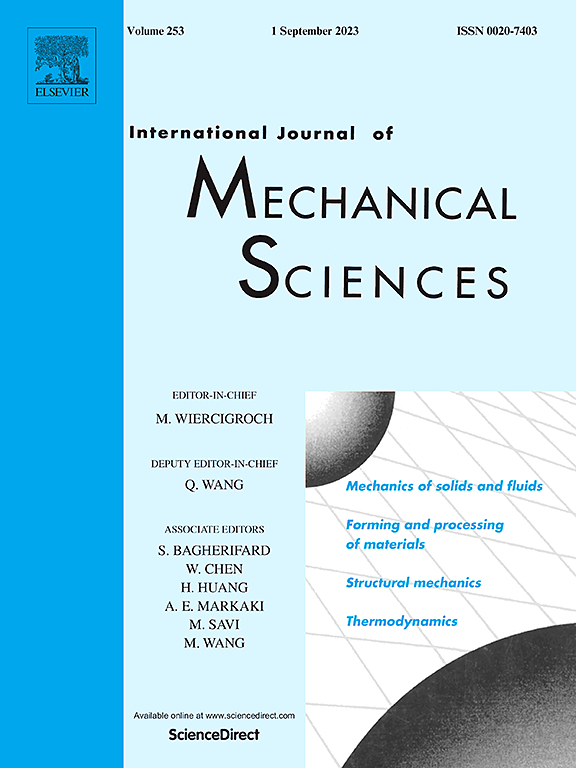Dynamic compressive behavior of Miura-ori metamaterials filled with shear thickening fluid
IF 7.1
1区 工程技术
Q1 ENGINEERING, MECHANICAL
International Journal of Mechanical Sciences
Pub Date : 2025-01-25
DOI:10.1016/j.ijmecsci.2025.110006
引用次数: 0
Abstract
This study firstly explores the dynamic compression behavior and energy absorption characteristics of Miura-ori structures enhanced with shear thickening fluid (STF), highlighting the effects of incorporating non-Newtonian fluids into cellular constructs. Employing a combination of experimental and numerical methods, this research elucidates the superior mechanical properties of STF-enhanced Miura-ori structures compared with their unfilled counterparts, particularly under varying dynamic compression speeds. An extensive parametric analysis assesses the impact of geometric configurations of the Miura-ori (including wall thickness and cell count), STF concentration levels (10%, 20%, and 30%), and compression velocities on the energy dissipation processes. This examination reveals the complementary interaction between the fluid's rheological behavior and the structural mechanics, leading to a notable improvement in energy absorption and average crushing force in STF-filled Miura-ori configurations. These variations are systematically analyzed across different conditions such as wall thickness, number of cells, and STF concentration. The study further contrasts the energy absorption capabilities between STF-filled Miura-ori and honeycomb structures filled with STF. It also compares the performance of STF with other filling materials like water and silicone oil, underscoring the distinct benefits of STF attributable to its shear-thickening properties. These properties markedly enhance energy absorption during the plateau phase and modify the commencement of densification. The findings of this study offer valuable perspectives on the application potential of STF in Miura-ori frameworks for scenarios necessitating elevated energy absorption under dynamic loads.

求助全文
约1分钟内获得全文
求助全文
来源期刊

International Journal of Mechanical Sciences
工程技术-工程:机械
CiteScore
12.80
自引率
17.80%
发文量
769
审稿时长
19 days
期刊介绍:
The International Journal of Mechanical Sciences (IJMS) serves as a global platform for the publication and dissemination of original research that contributes to a deeper scientific understanding of the fundamental disciplines within mechanical, civil, and material engineering.
The primary focus of IJMS is to showcase innovative and ground-breaking work that utilizes analytical and computational modeling techniques, such as Finite Element Method (FEM), Boundary Element Method (BEM), and mesh-free methods, among others. These modeling methods are applied to diverse fields including rigid-body mechanics (e.g., dynamics, vibration, stability), structural mechanics, metal forming, advanced materials (e.g., metals, composites, cellular, smart) behavior and applications, impact mechanics, strain localization, and other nonlinear effects (e.g., large deflections, plasticity, fracture).
Additionally, IJMS covers the realms of fluid mechanics (both external and internal flows), tribology, thermodynamics, and materials processing. These subjects collectively form the core of the journal's content.
In summary, IJMS provides a prestigious platform for researchers to present their original contributions, shedding light on analytical and computational modeling methods in various areas of mechanical engineering, as well as exploring the behavior and application of advanced materials, fluid mechanics, thermodynamics, and materials processing.
 求助内容:
求助内容: 应助结果提醒方式:
应助结果提醒方式:


